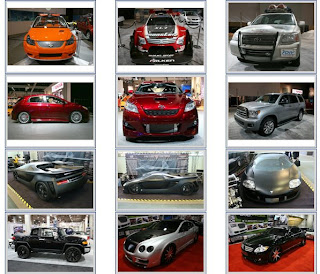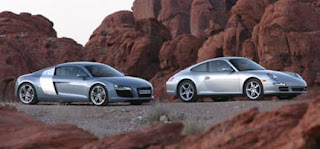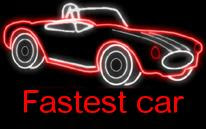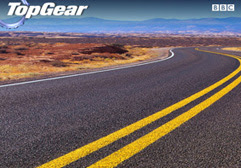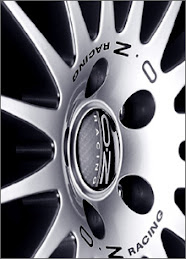
Bayerische Motoren Werke AG (BMW), is an independent German company and manufacturer of automobiles and motorcycles. BMW is the parent company of the MINI and Rolls-Royce car brands. It is also one of the leading German car manufacturers.
BMW was officially founded as a public company in 1922, but traces its origins to the pioneering days of German aviation all the way back to 1913. Two of these pioneering men, Karl Rapp and Gustav Otto, are credited by BMW as the "founding fathers". However, BMW owes its actual founding by three men- Josef Popp, Max Friz, and Camillo Castiglioni. These men brought BMW through many turbulent times in the company's early life, as well as taking the company public in 1922 to form BMW AG. Beginning with aircraft engines, BMW AG produced a variety of products in its early years, eventually moving to motorcycle production in 1923 and automobiles in 1929.
BMW started building motorcycle engines and then motorcycles after WWI. Their first notable motorcycle, the "R32" came in 1923. These had a "boxer twin" engine, in which an air-cooled cylinder protrudes into the air-fllow from each side of the machine. Other than a few post-war singles (basically to the same pattern), all their motorcycles had used this distinctive, unusual (but well-regarded) layout until the early 1980s. Many BMWs are still produced to this pattern, which is designated the "R series".
During WWII BMW produced the BMW R75 motorcycle with a sidecar attached. Unusually, the sidecar's wheel was also driven. Combined with a lockable differential, this made the vehicle very capable off-road, an equivalent in many ways to the Jeep.
In 1983 came the "K Series" (affectionately known as "The Flying Brick"), still shaft drive but now water cooled and with either 3 or 4 cylinders mounted in a straight line from front to back. Shortly after, BMW also started making the chain-driven F and G series with single and parallel twin Rotax engines.
BMW motorcycles have a range of models that give an off-road, sporty or relaxed and comfortable ride.
In the early 1990s, BMW updated the airhead boxer engine which became known as the Oilhead. In 2002, the Oilhead engine had two spark plugs per cylinder. In 2004 it added a built-in balance shaft, an increased capacity to 1170 cc and enhanced performance to 100 hp (75 kW) for the R1200GS, compared to 85 hp (63 kW) of the previous R1150GS. More powerful variants of the oilhead and hexhead engines are available in the R1100S and R1200S, producing 98 hp and 122 hp, respectively. also bow
 In 2004, BMW introduced the new K1200S Sports Bike which marked a departure for BMW. It is both powerful (the engine is a 167 hp unit derived from the company's work with the Williams F1 team) and significantly lighter than previous K models. It was BMW's latest attempt to keep up with the pace of development of sports machines from the likes of Honda, Kawasaki, Yamaha, and Suzuki. Innovations include a unique electronically adjustable front and rear suspension, and a Hossack-type front fork BMW calls Duolever.
In 2004, BMW introduced the new K1200S Sports Bike which marked a departure for BMW. It is both powerful (the engine is a 167 hp unit derived from the company's work with the Williams F1 team) and significantly lighter than previous K models. It was BMW's latest attempt to keep up with the pace of development of sports machines from the likes of Honda, Kawasaki, Yamaha, and Suzuki. Innovations include a unique electronically adjustable front and rear suspension, and a Hossack-type front fork BMW calls Duolever.
BMW was one of the earliest manufacturers to offer anti-lock brakes on production motorcycles starting in the late 1980s. The generation of anti-lock brakes available on the 2006 and later BMW motorcycles pave the way for the introduction of sophisticated electronic stability control, or anti-skid technology - a first for production motorcycles - later in the 2007 model year.
BMW has always been an innovator in motorcycle suspension design, taking up telescopic front suspension long before most other manufacturers. Then, when other makers caught up, they switched to Earles Forke, front suspension by swinging fork (1955 to 1969). Most modern BMWs are truly rear swingarm, single sided at the back (cf the regular swinging fork usually, and wrongly, called swinging arm).
Some BMWs started using yet another trademark front suspension design, the Telelever, in the early 1990s. Like the Earles Fork, the Telelever largely obviates dive under braking.
The current BMW model lineup is split into what is referred to as "Series", traditionally identified by a single digit - e.g. the 3 Series.
In 2004 BMW announced plans to make odd-numbered series saloon/sedan and estate/wagon models (BMW calls its estates/wagons Touring models), while even-numbered series will be two-door coupés and cabriolets. This convention started informally in 1976 with the introduction of the 6 Series and later continued in 1989 with the 8 Series, but died off when the latter was discontinued in 1999. This practice was revived as the Z4 replaced the aging Z3 roadster in 2003 and continues as the new 6 Series augments the existing BMW 5 Series.
The 1 Series is a brand entry-level vehicle which was launched in Fall 2004 and a 3-Door that was launched in July 2007 on the BMW International website. Because it is the only rear wheel drive vehicle in its class, it is considered the heir apparent to the original 2002 sport sedan from the 1960s. A Coupé has been announced for late 2007, and there are concepts for a convertible. U.S. introduction for the 1 series is expected in MY 2008 as a coupé and convertible, in the 128i and the 135i. The 1 series pricing fits neatly between MINI and the current E90 3-series.
The BMW 3 Series is a compact executive car manufactured since MY 1975. The E90 is the 5th generation 3 series. Available from MY 2005 to present, it is offered as the sport sedan(E90), sport wagon(E91), sport coupe(E92), and sport coupe convertible(E93). The E90 series is completely re-engineered from the E46, including changes to motor choices, transmission, the passenger compartment comfort, suspension technology, as well as a host of High-Tech features and options.
The BMW 5 series has been one of BMW's "experimenal" cars, in which they can explore newer ideas. They have inserted new technologies and new ideas into this model that may have seemed radical for its time. One such example of this "testing" approach is the new headlight design. These types of changes to the 5 Series have allowed BMW to assess the reaction of consumers to their new designs before expanding the changes to other model series. Consequently, it has at times led people to question BMW's approach to design.
The M5 is the motorsport division's version of the 5 Series. The new M5 (built on the E60 5 series chassis) is powered by a F1-inspired V10 engine, producing 507 hp and is mated with a 7-speed Sequential Manual Gearbox (SMG) transmission, which is capable of a delimited top speed of about 330 km/h (production variants are restricted to 250 km/h, or 155 mph). BMW has also recently added a 6-speed manual transmission for newer 2007 models. The colour palette differs from its more modest 5 Series siblings.
The 6 Series is BMW's grand touring luxury sport coupé. Currently available as the 650i in coupé and coupé convertible, the 6 series returned in 2004, after a 15 year absence from BMW's model lineup.
Although many spy photos were seen with the 6-Series having a half-life update, like the 5-Series, BMW released the updated 6-Series in July 2007. It is unknown when the M6 coupe & cabriolet update versions will be released, however both are expected soon.
M6: A high performance version of the 6 Series. Developed by BMW's M Division, it is powered by the same 5.0 L V10 507 hp engine seen in the BMW M5. It is currently available in Europe, North America and Australia.
BMW's full-size flagship executive sedan. Typically, BMW introduces much of their innovations first in the vaunted 7 series. It has been deemed a "sports car at the helm and a limousine in the rear". Numerous landmark and breakthrough technologies for the entire automotive industry debut on the 7 series. For example, the groundbreaking and controversial iDrive, or the world's first Hydrogen powered production vehicle, have all debuted in the 7 series. The 7-Series Hydrogen, the world’s first luxury performance sedan with hydrogen drive, it runs on the most plentiful element in the world and emits virtually nothing but water vapor. And because the infrastructure for refueling a hydrogen internal combustion engine is not yet complete, the V12 engine also runs on gasoline, enabled via a push button system. Numerous engines power the 7 series worldwide. BMW offers diesel, V8 and V12 motors, as well as the Alpina tuned supercharged V8. Additionally, the 760Li is also made in a bulletproof version.
BMW's second SUV debuted in 2004 (called SAV or Sports Activity Vehicle by BMW) and is based on the E46 3 Series layout within, but without, it is quite unique. For 2007, the X3 is powered by the N52 inline 6 cylinder engine that debuted with the 2006 E90 3 Series. The X3 is a more functionally oriented vehicle that American buyers seem to prefer over a wagon; it is BMW's answer to the growing crossover segment of the market. It has performed quite well in sales, but in 2007 a face lift was given to the X3, including an X-drive update, suspension adjustments, an engine upgrade, and aesthetics inside and out.
Marketed in Europe as an off-roader, it benefits from an advanced all-wheel drive system. This, combined with its standard "Enhanced DSC" stability control, make the X3 a capable vehicle on and off road.
The BMW X5 (E53) is a mid-size luxury SUV (SAV) sold by BMW since 2000. It features all-wheel drive and a line of straight-6 and V8 engines. For non-US models there is a 3.0 L diesel engine.
The BMW E70 automobile platform replaced the BMW E53 in November 2006. The E70-based X5 SUV features many new technological advancements including BMW's iDrive system as standard equipment and, for the first time in a BMW, an optional third row seat which has increased the seating capacity in the new X5 to 7 passengers.
The E53 model was rated the by IIHS in 2002 to be the safest vehicle that organization had ever tested. Since then, BMW has applied their craft to the current generation E70 to incorporate innovative "firsts" for the SUV/SAV industry, such as Run Flat Tires, complimentary BMW Assist, and a unique rear framing section to protect 3rd row occupants from injury due to an impact.
A 2-seater roadster and coupé which succeeded the Z3. For 2006 the Z4 Roadster is available as a 3.0i (3.0 L I6 with 215 hp), a 3.0si available with the new generation 3.0 L I6 with 255 hp, a 2.5si with a 2.5 I6 with 218 bhp or a 2.0i with a 150 bhp 2.0 L I4. The Z4 Coupé is available only in the high-performance 3.0si trim powered by the 3.0 L 255 HP I6.
Z4 M The new Z4 M roadster has been released as a Z4 with an E46 M3 motor (3.2 L, 343 hp) and also features the M braking and suspension systems.
BMW M GmbH (previously: BMW Motorsport GmbH) is a subsidiary of German car manufacturer BMW AG established in May 1972 with just eight employees. BMW M, also known as M-Technik or just "M" (for Motorsport) was initially created to facilitate BMW’s racing program, which was very successful in the 1960s and 1970s. The first racing project was BMW’s 3.0 CSL; in the late 1970s the first modified street legal road cars were produced for the contracted racecar drivers as their personal vehicles. By 1988, the number of employees had risen to 400.
Based on the 3 Series Coupe & Convertible, the M3 defined an entirely new market for BMW: a race ready production vehicle. Since its debut, the M3 is heralded in enthusiast circles, in large part due to its unique geometry and award winning powerplants. As a testament to how well received this vehicle is, all retired models have quickly made it to "collector" status. MY2008 marks the first time a Formula 1 inspired V8 will be offered., producing 420 hp (313 kW) that can reach 62 mph in about 4.5 seconds. The newest version (E92) will be available fall of 2007 in Europe, and second quarter of 2008 for the U.S.
Based on the 5 Series, the M5 is the M division's 500hp (373 kW) V10-powered version of the E60 5 series which makes 62 mph in 4.1 seconds, impressive for a 4 door saloon car. The M5 was the first 4-door sedan to be considered a sports car, and is the fastest production sedan on the planet. There is also a modified twin turbo version that can reach 62 mph in just 3.6 seconds, giving 810 bhp (604 kW) and 733 lp-ft (994 Nm) of torque, with a top speed of 240 mph (386 km/h). This makes it the fastest and most powerful luxury 4-door sedan ever produced.
The M6 is the M division's version of the E63. The M6 shares its drivetrain with the M5. The V10 produces 500 horsepower and 383 lb-ft of torque. This new engine is mated to a seven-speed SMG transmission.
BMW’s two-seater is powered by the same prize-winning 3.2-liter straight-six M engine also featured in the BMW M3(E46) and the BMW Z4 Roadster. The engine’s performance figures are: 3,246 cc displacement, 343 bhp maximum output at an engine speed of 7,900 rpm, maximum engine speed of 8,000 rpm. No less than 80 per cent of the engine’s maximum torque of 262 lb-ft is available at the driver’s request from just 2,000 rpm. Output per liter is 103 bhp, giving the Z4 M Coupe a power-to-weight ratio of just 9.9 lb/bhp. Acceleration to 60 mph comes in 4.8 seconds and top speed is limited electronically to 155 mph.









